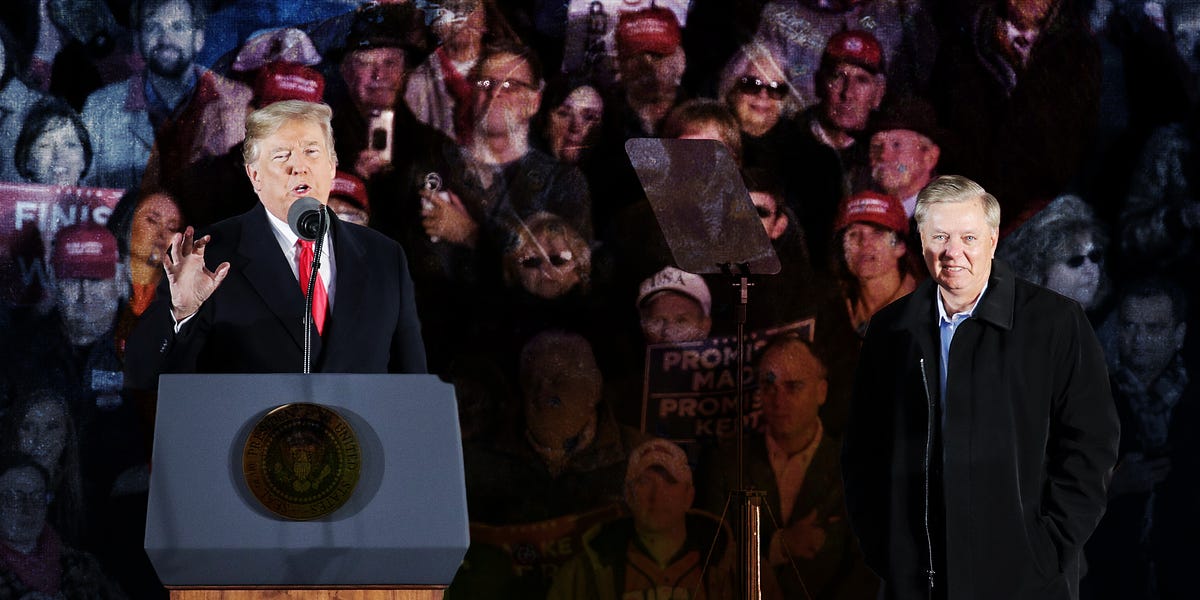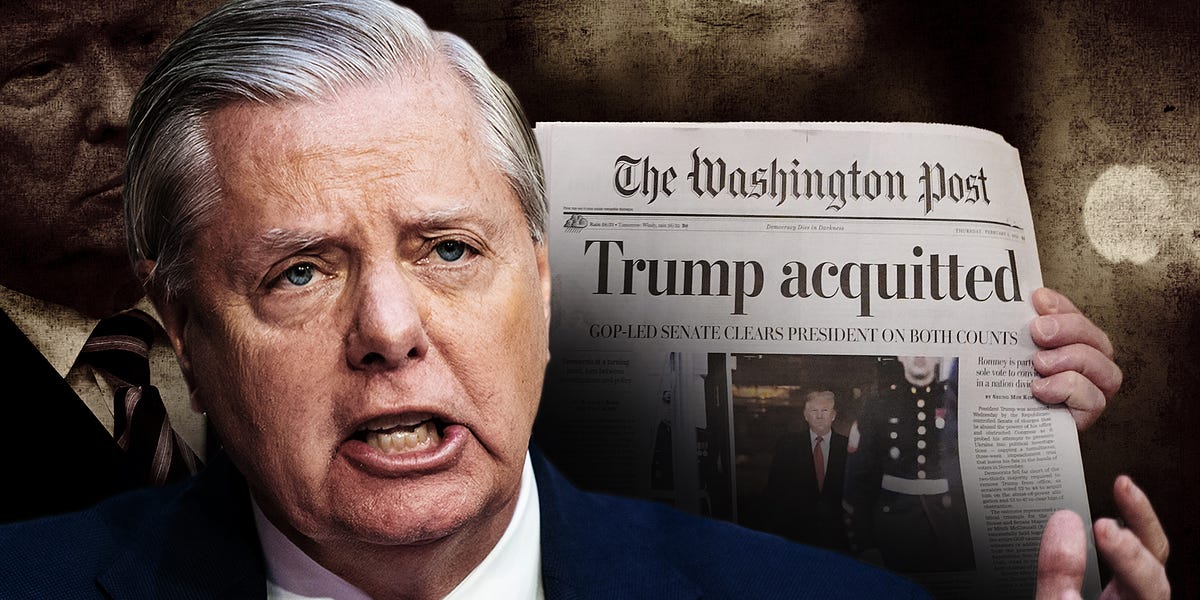lennypartiv
Diamond Member
- Jul 16, 2019
- 26,522
- 20,342
The GOP is the party of family values.Not with the way the MAGA and GOP have spat on morals for the past 40 years.
Follow along with the video below to see how to install our site as a web app on your home screen.
Note: This feature may not be available in some browsers.
The GOP is the party of family values.Not with the way the MAGA and GOP have spat on morals for the past 40 years.
No, it is not.The GOP is the party of family values.




THE REPUBLICAN PARTY WAS IN BIG TROUBLE, and Lindsey Graham knew it. It was January 21, 2016, and the senator was taking questions at a press conference. A month earlier, he had abandoned his campaign for the Republican presidential nomination. Now two men he despised, Donald Trump and Sen. Ted Cruz, were leading the race.
Graham thought either of them, if nominated, would lose the general election. Choosing between them, he told reporters, was “like being shot or poisoned. What does it really matter?”
Two months later, in March, Graham changed his mind. He endorsed Cruz and joked that it was better to be poisoned than shot. “Donald is like being shot in the head,” Graham told talk-show host Trevor Noah. “You might find an antidote to poisoning, I don’t know. But maybe there’s time.”
Graham was wrong. Trump wasn’t a shot to the head. He didn’t kill the GOP. In fact, he won the election.
Trump turned out to be poison. Over the next five years, he thoroughly corrupted Graham’s party. Republican leaders had time to counteract the poison, but they never did. One reason was that the poison moved slowly. Graham and other Republican politicians lost the ability to see what they were becoming. They rallied around an authoritarian, excused authoritarian acts, and embraced authoritarian ideas.
This is a story about how that happened.
BEFORE WE START, I should tell you what this article isn’t. It isn’t a rant about Graham’s servility or hypocrisy. And it isn’t a profile.
Many other journalists have written about Graham and Trump. Most of them have focused on the personal relationship between the two men. They examine the ways in which Graham’s evolution was distinctive.
I’m not interested in what’s distinctive about Graham. I’m interested in what isn’t. How does his story illuminate what happened to the whole Republican party? How did the poison work?
We need to answer these questions because the authoritarian threat is bigger than one man. Donald Trump’s ascent to the presidency destroyed the myth that the United States was immune to despotism. Our institutions and the people who run them are vulnerable. We have to confront these vulnerabilities and learn how to deal with them before our democracy is threatened again.
So why focus on Graham?
First, because he was a central player in the Republican party’s capitulation to Trump. And second, because he talked constantly. He produced an enormous trove of interviews, speeches, press briefings, and social media posts. Through these records, we can see how he changed, week to week and month to month. We can watch the poison work.
It’s a slow death. The surrender to despotism doesn’t happen all at once. It advances in stages: a step, a rationalization. Another step, another rationalization. The deeper you go, the more you need to justify. You say what you need to say. You believe what you need to believe.
So let’s go back to the beginning. Let’s see who Lindsey Graham was before he drank the poison.

The Corruption of Lindsey Graham
A case study in the rise of authoritarianism. Sen. Lindsey Graham is a central player in the Republican party’s capitulation to Donald Trump. We can watch the GOP's turn to authoritarianism by reviewing Graham's many public statements.specialto.thebulwark.com






Graham didn’t mention at the press conference that he had privately threatened to invoke the Twenty-fifth Amendment. But given Trump’s behavior on January 6th, he held out the possibility of using that provision. “I don’t support an effort to invoke the Twenty-fifth Amendment now,” he said. But “if something else happens, all options would be on the table.”Reporter 1: Do you trust the president not to incite the kind of violence that he promoted yesterday in the next two weeks?
Graham: I’m hoping he won’t. I’m hoping that he will allow [Chief of Staff] Mark Meadows to continue the transition. . . . My hope is that we can move forward in the next 14 days. But this will depend on what the president does. . . .
Reporter 2: Senator, do you believe that the events yesterday disqualify the president from seeking the office again in the future?
Graham: I’m not worried about the next election. I’m worried about getting through the next 14 days.

Allof this typing and there has to be belief in who you are trying to convince. People who voted for him saw near the whole media and entertainment industries use vile tactics any chance they had to take him down. This from before the 2016 Presidential election. And as we know no, Progs did not steal enough votes. They made sure that was not repeated in 2020.Part 3
Summer of Rage
IN MAY, POLICE OFFICERS IN MINNEAPOLIS killed a black man, George Floyd, in the course of arresting him for allegedly passing a fake $20 bill. The killing—for which one officer was later convicted of murder—was captured on video and broadcast everywhere. Protests and riots erupted in many cities, and Trump responded by threatening to send in troops. “Liberal Governors and Mayors must get MUCH tougher or the Federal Government will step in and do what has to be done,” he tweeted. “And that includes using the unlimited power of our Military.”
Graham endorsed the president’s threat. “I fully support the use of federal forces, if necessary, to restore order,” he wrote. Three weeks later, as some people tore downstatues in protest over police violence and other grievances, Graham condemned these troublemakers as domestic enemies. “We’re at war with them, politically. They want to destroy America as we know it,” Graham told Fox News viewers. “To the listeners out there: You may not believe you’re in a war. But you are, politically. And you need to take sides, and you need to help this president.”
In Washington, Trump and Graham wielded power without remorse. In September, Justice Ruth Bader Ginsburg died, and Republicans—having already installed two Supreme Court justices during Trump’s term—vowed to ram through a third.
Grabbing the third court seat was, like the pardons, constitutionally permitted. But it was an egregious betrayal. In 2016, Graham and his Republican colleagues had refused to let President Obama fill a vacant Supreme Court seat on the grounds that it was an election year. In 2018, Graham had pledged to apply the same rule to Trump. “If an opening comes in the last year of President Trump’s term, and the primary process has started, we’ll wait till the next election,” Graham promised at the time.
Now Graham abandoned that promise. “The rules have changed,” he declared. Speaking for his Republican colleagues, he vowed, “None of us are going to blink.”
As Election Day approached, Graham made the rounds on conservative radio and TV, raising money by hawking himself as a Trump diehard and scourge of liberals. “They hate my friggin’ guts,” he boasted on Sean Hannity’s radio show on September 17. “Let’s kick their ass.” A week later, on Mark Levin’s show, he bragged, “The liberals hate me for Kavanaugh. They hate me for Trump. . . . I need people listening to your radio show, if you can afford five or ten bucks, go to LindseyGraham.com.”
Meanwhile, Trump prepared his followers for battle. He claimed that massive election fraud was underway, and he refused to say that he would surrender power if he lost the official vote count. “The Democrats are trying to rig this election, because that’s the only way they’re going to win,” he alleged on September 12. When reporters asked whether he would “accept the results of the election” and commit to a “peaceful transferral of power,” he refused to answer. “There won’t be a transfer,” he said. “There’ll be a continuation.”
On October 7, during the vice presidential debate, moderator Susan Page noted Trump’s ominous statements. She asked Mike Pence: “If Vice President Biden is declared the winner and President Trump refuses to accept a peaceful transfer of power . . . what would you personally do?”
Graham ridiculed the question. Page’s query “about a peaceful transfer of power was the dumbest question in the history of #VPDebates,” he tweeted. “Only in Washington is this an issue.”
Even after multiple threats by Trump to defy the election results, Graham kept feeding the fires of rage. On October 31, at a rally in Conway, South Carolina, the senator bragged that liberals “hate my guts.” He pledged to stand with Trump, and he celebrated the president as America’s bully. “Donald Trump has got everybody you want to be scared, scared,” Graham told the crowd, naming Mexico and China in particular. He joked that he had warned foreign leaders about Trump: “He’s a little crazy. I’d watch what I do, If I were y’all.”
But it wasn’t Mexico or China that Trump was about to attack. It was the United States.

Corruption of Lindsey Graham: The First Impeachment
To the president’s critics, his coercion of Ukraine was confirmation of his unfitness for office. But his supporters saw a pattern of persecution: Trump had faced one investigation after another not because he had broken laws but because his enemies controlled the investigating entities—the...specialto.thebulwark.com
These actions, if they continue, will incite more violence. Every time you asked President Trump to calm his people down, to reject violence, to move on, he has done it. Now, how has he been met? I think outrageous misconduct by the Congress itself. . . . What good comes from impeaching President Trump after he’s out of office? . . . It will divide the country. It will incite violence. . . . If you want to end the violence, end impeachment.

Do you know who Will Saletan is? Have you bothered to research about him?Allof this typing and there has to be belief in who you are trying to convince. People who voted for him saw near the whole media and entertainment industries use vile tactics any chance they had to take him down. This from before the 2016 Presidential election. And as we know no, Progs did not steal enough votes. They made sure that was not repeated in 2020.
Here are some of the lessons I learned.
Because you are lazy?Why should I believe this is anything other than you rambling off opinions and claiming they are based on "research"?